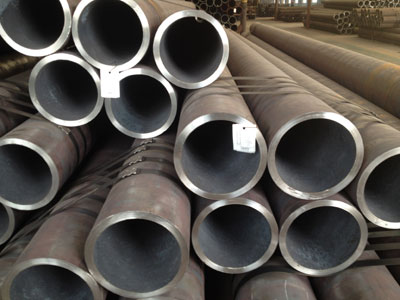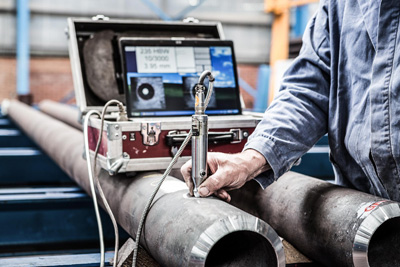 What’s New?
What’s New?
- Cause of well casing pipe damage and repairing technology
- How many steps are needed in the process of pipelines built?
- What are the commonly used welding methods for oil pipelines
- Do you know new anti-corrosion technologies for pipelines
- Development trend of global continuous pipe drilling technology
Seamless pipes

Seamless steel pipe is one of the important products in OCTG products. It is widely used in the manufacture of structural parts and mechanical parts, such as oil drill pipe, automobile transmission shaft, bicycle frame and construction of steel scaffolding and so on. Comparing with the other steel pipe, seamless steel pipe has stronger anti-bending and torsional ability under the condition of the same cross section area. It is widely used in the national economy, and is entitled to the "industrial blood vessel". Therefore, the quality of seamless steel pipe has very demanding requirements.
Seamless pipe is formed when steel in the billet is heated and then either pushed or pulled over a mandrel with a piercing point located in the center of the billet. This produces a hollow tube or "shell". The tube is then further processed until it becomes the desired size and wall thickness. The whole manufacturing process doesn’t involve any welding part, so there is no welding line in seamless pipes.
We provide welded pipe specifications:
Steel Grade: B, X42, X52, X60, X65, X70Dimension: 1"/2"---24"
Process: HOT ROLLING, Hot Expanding, SSAW
Steel Grade: B, X42, X52, X60, X65, X70, X80
Dimension: 5" -- 48"
Process: SSAW
Mechanical Properties-Tensile Requirements
| Seamless | Grade A | Grade B |
|---|---|---|
| Tensile Strength, min, psi | 48,000 | 60,000 |
| Yield Strength | 30,000 | 35,000 |
Advantages of seamless pipe
Seamless pipe owns three unique advantages, namely high pressure endurance, great strength and uniformity of structure.
Seamless pipe is most favored by its high pressure endurance. Normally, the weakest part of pipes is the welding line, but seamless pipe doesn’t have a seam, so the entire circumference of the pipe can evenly withstand high pressure. Besides, owing to the lack of the welding line, seamless pipe is able to support its own weight as well the heavy loaded weight, and maintain its original structure. There advantages bring seamless pipe a number of commercial applications, not only in oil field, but also in ship building, offshore rigs, pressure vessel and so on.
Seamless steel pipe inspection
Seamless steel pipe inspection generally include: inspection geometry, surface quality; test chemical composition, mechanical properties, process performance, high and low times of the organization; NDT inspection; some special performance inspection and weighing length measurement. Let’s look at some relatively important quality inspection together.
Seamless steel tube geometry inspection
- Seamless steel pipe wall thickness inspection Micrometer is the main tool that is adopted. When you check, left hand holds the micrometer stand, with right hand rotation induced wheel, and the wire rod should be coincident with the diameter of the measuring point. Once found that the wall thickness is not qualified, it should be marked in time.
- Outside diameter, ellipse of seamless steel pipe inspection Calipers, vernier caliper should be taken. The caliper should be perpendicular to the axis of the steel pipe in checking, measuring the maximum and the minimum point when the pipe rotated slowly. Founding the outer diameter of large or small, you should mark it in time.
- Seamless steel tube length inspection The steel tape can be measured directly by metallic tape.
- Bending inspection of seamless steel tubes With the tools of level, feeler and line.
- End profile inspection At two ends of the steel tube should be cut into specified angle and remove burrs. The method of inspection adopts angle square and general use tube end groove clamp in the field.
Non-destructive testing of seamless steel pipe

Nondestructive Testing, shorted for NDT, is a widely-used method in pipeline inspection. It is a process of testing, inspecting and evaluating the quality and characteristics of the material without damaging the pipeline itself or affecting the later regular work of the pipe. In other words, after NDT testing, the part can still be put into practical use. NDT utilizes the changes in heat, sound and magnets caused by abnormal inner structure or flaws to inspect the internal and external defects of the material.
The common inspection methods of NDT are visual testing (VT), ultrasonic testing (UT), radiographic testing (RT), hydrostatic testing. Anson International co, ltd uses ultrasonic testing (UT) and hydrostatic testing to inspect its line pipes.
In order to verify the mechanical properties of seamless steel pipe to meet the requirements of the standard, the test sample of seamless steel pipe mechanical performance should be prepared carefully. Mechanical property test includes tensile strength, yield strength, elongation, impact energy and so on. Process performance test includes flattening test, flaring test, hydrostatic testing, curling trials, cold bend test, perforation test. These test items are based on different standards and different uses of seamless steel tubes.
